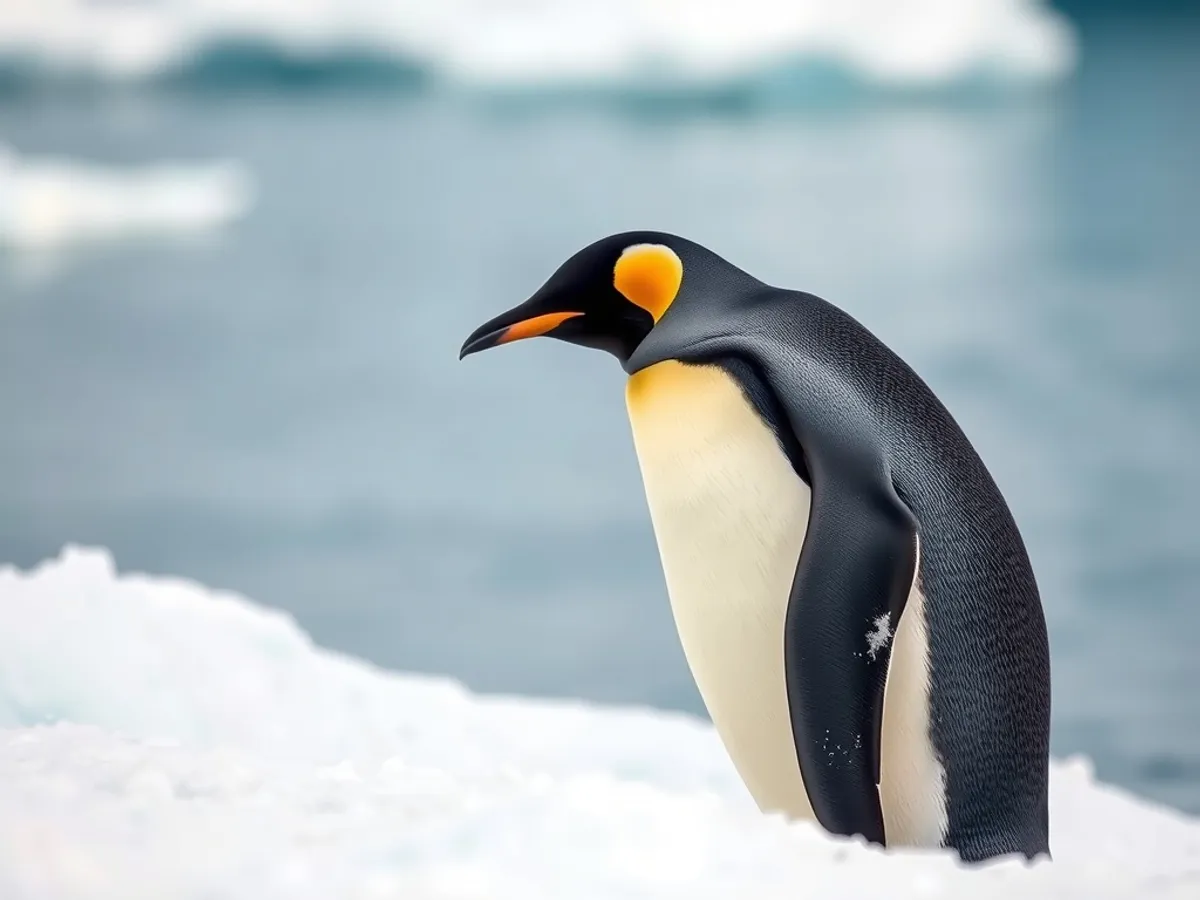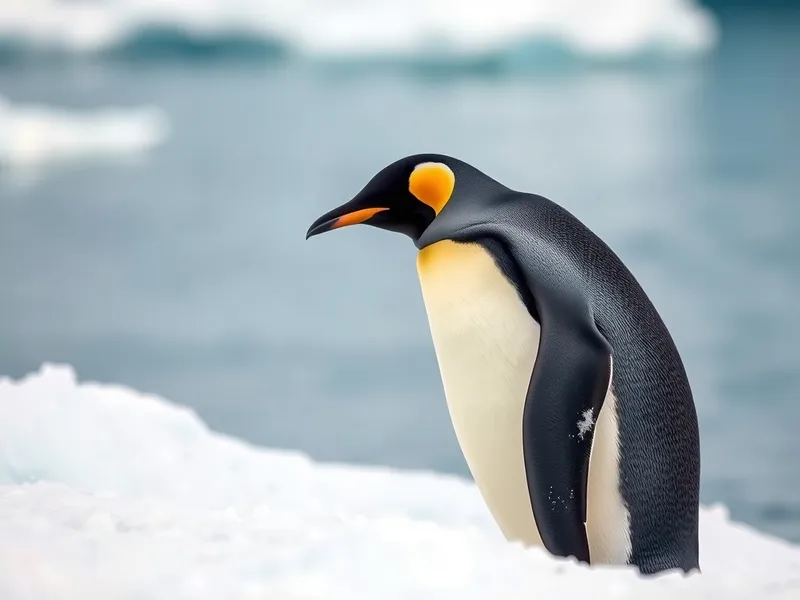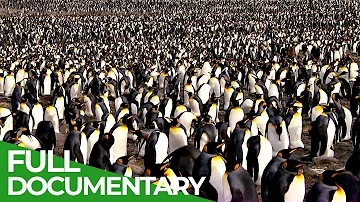
Emperor Penguin
Aptenodytes forsteri

Meet the Emperor Penguin
The Emperor Penguin is the largest of all penguin species and is native to Antarctica. These flightless birds are renowned for their remarkable breeding cycle, enduring the continent’s harsh winter to incubate their eggs. Emperor Penguins have a striking appearance, with black heads, backs and wings, white bellies, and yellow-orange markings on their necks. They form large colonies on the sea ice, exhibiting fascinating social behaviors to survive extreme cold.
Classification
Bird
Habitat
Antarctic sea ice and coastal regions
Diet
Carnivore
Lifespan
15-20 years
Conservation
Near Threatened
Weight
22–45 kg
📖Fascinating Facts
Largest Penguin
Emperor Penguins can reach up to 1.2 meters (nearly 4 feet) tall, making them the tallest and heaviest living penguin species.
Unique Parenting
Male Emperor Penguins keep eggs warm on their feet under a flap of skin called a brood pouch, fasting for around two months until the chicks hatch.
Extreme Survivors
Emperor Penguins withstand Antarctica’s brutal winter, enduring temperatures below -60°C (-76°F) and fierce winds by huddling together in large groups.
📋Detailed Description
The Emperor Penguin (Aptenodytes forsteri) is the largest of all living penguin species, with adults typically standing about 115 cm (45 in) tall and weighing between 22 and 45 kg (49–99 lbs), though weights fluctuate seasonally. Their plumage is highly specialized for Antarctic conditions, featuring dense, overlapping feathers that provide exceptional insulation, and a thick layer of subcutaneous fat for additional warmth. The head, chin, and throat are deep black, sharply contrasting with the pale yellow upper breast and vivid yellow-orange ear patches. Their beak is long and slender, with a pinkish or orange lower mandible. Emperor Penguins are highly social, forming breeding colonies that can number in the thousands. They are uniquely adapted to breed during the Antarctic winter, enduring temperatures as low as −60°C (−76°F) and winds exceeding 200 km/h (124 mph). Their vocalizations are complex, enabling individual recognition among mates and chicks in crowded colonies. They are powerful swimmers, capable of diving to depths over 500 meters (1,640 ft) and remaining submerged for up to 27 minutes, making them the deepest and longest-diving of all penguins. Their diet consists primarily of fish, but also includes squid and krill. Emperor Penguins play a crucial role in the Antarctic ecosystem as both predators and prey, and their life history is tightly linked to the dynamics of sea ice.
💡 Did you know?
Emperor Penguins can hold their breath for up to 20 minutes while hunting underwater.
🔬Research & Sources
Wikipedia Summary
The emperor penguin is the tallest and heaviest of all living penguin species and is endemic to Antarctica. The male and female are similar in plumage and size, reaching 100 cm (39 in) in length and weighing from 22 to 45 kg. Feathers of the head and back are black and sharply delineated from the white belly, pale-yellow breast and bright-yellow ear patches.
Last Modified: 5/29/2025
🎭Behavior & Social Structure
Emperor Penguins are diurnal, with activity patterns closely tied to light availability and breeding cycles. Foraging occurs at sea, where they hunt individually or in small groups, using coordinated pursuit and rapid underwater maneuvers to catch prey. Their hunting dives are typically between 100 and 300 meters deep, but can exceed 500 meters. On land, they exhibit remarkable social cohesion, especially during the breeding season when adults huddle together in dense formations to conserve heat. These huddles are dynamic, with individuals regularly rotating positions to ensure equitable warmth distribution. Vocal communication is central to social interactions, with each penguin possessing a unique call signature. Chicks form crèches (nursery groups) for protection while both parents forage. Aggressive interactions are rare but can occur over territory or mate access. Daily routines shift seasonally, with increased foraging during chick-rearing and fasting periods during incubation.
👶Reproduction & Life Cycle
Emperor Penguins have a highly specialized reproductive strategy. Breeding begins in late March to April, when adults trek 50–120 km (31–75 mi) inland to traditional colony sites on stable sea ice. Courtship involves mutual vocalizations and displays. Females lay a single egg in May or June, after which they transfer it to the male, who incubates it on his feet under a brood pouch for about 64 days. During this period, males fast and rely on fat reserves, losing up to 45% of their body weight. Females return to the sea to feed and return around hatching time to relieve the male and feed the newly hatched chick by regurgitation. Parental care is biparental, with both sexes alternating foraging trips and chick brooding. Chicks fledge at 5–6 months, typically in December or January, when sea ice begins to break up.
🛡️Adaptations & Survival
Emperor Penguins exhibit a suite of adaptations for extreme cold and deep diving. Their dense plumage and thick blubber layer provide insulation against subzero temperatures. Counter-current heat exchange in their flippers and legs minimizes heat loss. Their nasal passages recover heat and moisture from exhaled air. Behaviorally, they huddle in large groups to reduce individual heat loss, with coordinated movement ensuring all members benefit. Physiologically, they can reduce their metabolic rate and shunt blood away from extremities during dives, allowing them to tolerate low oxygen levels (hypoxia) and high pressure. Their solid bones reduce buoyancy, aiding deep dives, and their hemoglobin has a high affinity for oxygen. Their reproductive timing is synchronized with the Antarctic winter to ensure chicks are ready to fledge when food is most abundant.
🎨Cultural Significance
Emperor Penguins have become iconic symbols of Antarctic wildlife and resilience, frequently featured in documentaries, films (notably 'March of the Penguins' and 'Happy Feet'), and conservation campaigns. They are emblematic of the challenges facing polar ecosystems in a warming world. While they hold no traditional uses for indigenous peoples (as Antarctica has no native human population), their image is widely used in educational and scientific outreach. Emperor Penguins also serve as flagship species for Antarctic conservation efforts and are the subject of extensive scientific and popular literature.
🔬Recent Research & Discoveries
Recent research has focused on the impacts of climate change on Emperor Penguin breeding success and colony distribution, with satellite imagery revealing previously unknown colonies and tracking population trends. Studies using biologging devices have provided new insights into their diving physiology, foraging ecology, and migratory movements. Genetic analyses indicate low genetic diversity, raising concerns about adaptability to rapid environmental change. Ongoing research is investigating the effects of shifting sea ice patterns on chick survival and adult foraging efficiency. The use of remote sensing and automated camera systems is revolutionizing population monitoring, enabling more accurate and less invasive data collection.
🎥Wildlife Videos

Wildlife - Just Penguins | Free Documentary Nature
Wildlife - Episode 2: Just Penguins | Wildlife Documentary Watch 'Wildlife - Episode 3' here: https://youtu.be/eiqeZwk7NhI This ...
Free Documentary - Nature

Emperor Penguin Societies (Full Episode) | Secrets of the Penguins | National Geographic
In Antarctica, emperor penguin societies reveal mysterious bonds forged from birth. These bonds are the secret to surviving their ...
National Geographic

South Georgia - Penguin Paradise of the South Atlantic | Free Documentary Nature
In the middle of the Antarctic Ocean, an entire mountain range arises from the water: South Georgia, the nursery of the Antarctic.
Free Documentary - Nature

Emperor penguins | The Greatest Wildlife Show on Earth | BBC Earth
Welcome to BBC EARTH! The world is an amazing place full of stories, beauty and natural wonder. Here you'll find 50 years worth ...
BBC Earth

Best Penguin Moments | BBC Earth
Living in some of the coldest, harshest conditions on Earth means that every day is a struggle to survive. From facing off against ...
BBC Earth

Emperor penguin chicks jump off a 50-foot cliff in Antarctica NEVER-BEFORE-FILMED FOR TV | Nat Geo
National Geographic and BAFTA Award-winning cinematographer Bertie Gregory release unprecedented footage of Emperor ...
National Geographic
🌍Habitat Information
The Emperor Penguin typically inhabits Antarctic sea ice and coastal regions environments. Emperor Penguins have adapted to their environments with specialized features and behaviors.
Primary Habitat:
Antarctic sea ice and coastal regions
More detailed habitat information will be available soon.
🛡️Conservation Status
The Emperor Penguin is currently classified as Near Threatened. Conservation efforts are crucial for preserving this species for future generations.
Common Threats:
- 🏠Habitat loss and fragmentation
- 🌡️Climate change impacts
- 🎯Hunting and poaching
- 🏭Human-wildlife conflict
⚠️Threats & Conservation Challenges
The primary threats to Emperor Penguins are climate change and associated sea ice loss, which impact breeding habitat stability and prey availability. Changes in sea ice dynamics can lead to colony failures, as eggs and chicks are vulnerable to exposure and predation if ice breaks up prematurely. Overfishing of key prey species (such as Antarctic silverfish and krill) and potential oil spills pose additional risks. Human disturbance is minimal due to the remote habitat, but increasing tourism and research activity may have localized effects. Disease outbreaks, though currently rare, represent a potential future threat. Population estimates suggest approximately 256,500 breeding pairs, but trends are uncertain and some colonies have experienced recent declines. The species is classified as Near Threatened by the IUCN, with ongoing monitoring and climate mitigation efforts recommended.
🔬Scientific Classification
Scientific Name
Aptenodytes forsteri
Classification Hierarchy
🔍 About Taxonomic Classification
Taxonomic classification is a hierarchical system used by scientists to classify and organize living organisms based on shared characteristics and evolutionary relationships.
The system moves from broad categories (Kingdom) to increasingly specific ones, with each animal's scientific name typically consisting of its Genus and species.
📝Community Notes
Share your observations and insights about the Emperor Penguin with our community of wildlife enthusiasts.
Join Our Community
Sign in to share your observations and connect with fellow wildlife enthusiasts.
Sign In to ContributeNo community notes yet
Be the first to share your observations about the Emperor Penguin!
Explore Emperor Penguin
Select a tab above to learn more about this amazing animal.
📸Photo Gallery
No photos available for this animal yet.
🌟Discover More Wildlife
Continue your journey of discovery with more fascinating animals from our database
